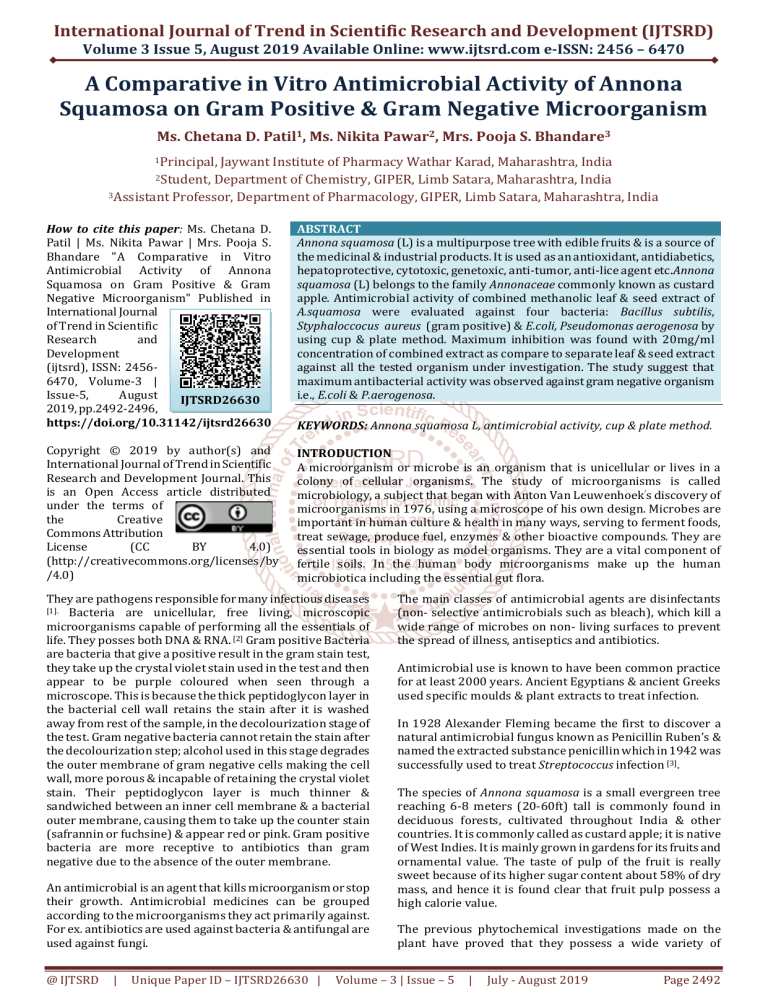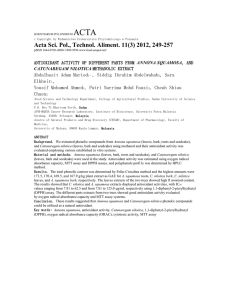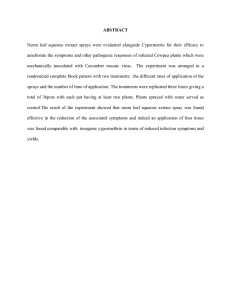
International Journal of Trend in Scientific Research and Development (IJTSRD)
Volume 3 Issue 5, August 2019 Available Online: www.ijtsrd.com e-ISSN: 2456 – 6470
A Comparative in Vitro Antimicrobial Activity of Annona
Squamosa on Gram Positive & Gram Negative Microorganism
Ms. Chetana D. Patil1, Ms. Nikita Pawar2, Mrs. Pooja S. Bhandare3
1Principal,
Jaywant Institute of Pharmacy Wathar Karad, Maharashtra, India
Department of Chemistry, GIPER, Limb Satara, Maharashtra, India
3Assistant Professor, Department of Pharmacology, GIPER, Limb Satara, Maharashtra, India
2Student,
How to cite this paper: Ms. Chetana D.
Patil | Ms. Nikita Pawar | Mrs. Pooja S.
Bhandare "A Comparative in Vitro
Antimicrobial Activity of Annona
Squamosa on Gram Positive & Gram
Negative Microorganism" Published in
International Journal
of Trend in Scientific
Research
and
Development
(ijtsrd), ISSN: 24566470, Volume-3 |
Issue-5,
August
IJTSRD26630
2019, pp.2492-2496,
https://doi.org/10.31142/ijtsrd26630
ABSTRACT
Annona squamosa (L) is a multipurpose tree with edible fruits & is a source of
the medicinal & industrial products. It is used as an antioxidant, antidiabetics,
hepatoprotective, cytotoxic, genetoxic, anti-tumor, anti-lice agent etc.Annona
squamosa (L) belongs to the family Annonaceae commonly known as custard
apple. Antimicrobial activity of combined methanolic leaf & seed extract of
A.squamosa were evaluated against four bacteria: Bacillus subtilis,
Styphaloccocus aureus (gram positive) & E.coli, Pseudomonas aerogenosa by
using cup & plate method. Maximum inhibition was found with 20mg/ml
concentration of combined extract as compare to separate leaf & seed extract
against all the tested organism under investigation. The study suggest that
maximum antibacterial activity was observed against gram negative organism
i.e., E.coli & P.aerogenosa.
Copyright © 2019 by author(s) and
International Journal of Trend in Scientific
Research and Development Journal. This
is an Open Access article distributed
under the terms of
the
Creative
Commons Attribution
License
(CC
BY
4.0)
(http://creativecommons.org/licenses/by
/4.0)
INTRODUCTION
A microorganism or microbe is an organism that is unicellular or lives in a
colony of cellular organisms. The study of microorganisms is called
microbiology, a subject that began with Anton Van Leuwenhoek’s discovery of
microorganisms in 1976, using a microscope of his own design. Microbes are
important in human culture & health in many ways, serving to ferment foods,
treat sewage, produce fuel, enzymes & other bioactive compounds. They are
essential tools in biology as model organisms. They are a vital component of
fertile soils. In the human body microorganisms make up the human
microbiotica including the essential gut flora.
KEYWORDS: Annona squamosa L, antimicrobial activity, cup & plate method.
They are pathogens responsible for many infectious diseases
[1]. Bacteria are unicellular, free living, microscopic
microorganisms capable of performing all the essentials of
life. They posses both DNA & RNA. [2] Gram positive Bacteria
are bacteria that give a positive result in the gram stain test,
they take up the crystal violet stain used in the test and then
appear to be purple coloured when seen through a
microscope. This is because the thick peptidoglycon layer in
the bacterial cell wall retains the stain after it is washed
away from rest of the sample, in the decolourization stage of
the test. Gram negative bacteria cannot retain the stain after
the decolourization step; alcohol used in this stage degrades
the outer membrane of gram negative cells making the cell
wall, more porous & incapable of retaining the crystal violet
stain. Their peptidoglycon layer is much thinner &
sandwiched between an inner cell membrane & a bacterial
outer membrane, causing them to take up the counter stain
(safrannin or fuchsine) & appear red or pink. Gram positive
bacteria are more receptive to antibiotics than gram
negative due to the absence of the outer membrane.
An antimicrobial is an agent that kills microorganism or stop
their growth. Antimicrobial medicines can be grouped
according to the microorganisms they act primarily against.
For ex. antibiotics are used against bacteria & antifungal are
used against fungi.
@ IJTSRD
|
Unique Paper ID – IJTSRD26630 |
The main classes of antimicrobial agents are disinfectants
(non- selective antimicrobials such as bleach), which kill a
wide range of microbes on non- living surfaces to prevent
the spread of illness, antiseptics and antibiotics.
Antimicrobial use is known to have been common practice
for at least 2000 years. Ancient Egyptians & ancient Greeks
used specific moulds & plant extracts to treat infection.
In 1928 Alexander Fleming became the first to discover a
natural antimicrobial fungus known as Penicillin Ruben’s &
named the extracted substance penicillin which in 1942 was
successfully used to treat Streptococcus infection [3].
The species of Annona squamosa is a small evergreen tree
reaching 6-8 meters (20-60ft) tall is commonly found in
deciduous forests, cultivated throughout India & other
countries. It is commonly called as custard apple; it is native
of West Indies. It is mainly grown in gardens for its fruits and
ornamental value. The taste of pulp of the fruit is really
sweet because of its higher sugar content about 58% of dry
mass, and hence it is found clear that fruit pulp possess a
high calorie value.
The previous phytochemical investigations made on the
plant have proved that they possess a wide variety of
Volume – 3 | Issue – 5
|
July - August 2019
Page 2492
International Journal of Trend in Scientific Research and Development (IJTSRD) @ www.ijtsrd.com eISSN: 2456-6470
compounds like acetogenins which are responsible for antifeedant, anti-malarial, cytotoxic & the immunosuppressive
activities. Diterpenes which was isolated from the Annona
squamosa possess the Anti-HIV principle and the antiplatelet aggregation activity. The partially purified
flavonoids were reported from the same source as the
responsible agent for the anti-microbial and other pesticidal
activities [4].The leaves of the plants have been used as
insecticide, anthelmintic ,styptic, externally used as
suppurant.Unripe and dried fruit work as antidysentric. Bark
is used as powerful astringent, antidysentric and vermifuge.
Figure No:-4 Fruits of Annona squamosa
Chemical ConstituentsIt contains alkaloids, glycosides, saponins, phenolic
compounds, flavanoids, oils, steroids, and triterpins. The
diterpenoid atisine is the most abundant alkaloid in the
roots. It also contains alkaloids oxophoebine, reticuline,
isocorydine & methylcorydaldine & the flavanoid quercetin3-O-glucoside.It also contain linalool, geraniol, borneol,
eugenol, farnesol, acetogenin. It also contains annotemoyin,
squamosin & glucopyranoside [8, 9].
Figure No:-1- Whole Plant of Annona squamosa
Structure:
Geraniol
Figure No:-2 Leaves of Annona squamosa
Linalool
Figure No:-3 Flowers of Annona squamosa
Borneol
@ IJTSRD
|
Unique Paper ID – IJTSRD26630 |
Volume – 3 | Issue – 5
|
July - August 2019
Page 2493
International Journal of Trend in Scientific Research and Development (IJTSRD) @ www.ijtsrd.com eISSN: 2456-6470
MATERIALS AND METHODS
Collection and AuthenticationThe fully matured fresh leaves and seeds of Annona
squamosa were collected from Pawarwadi in Satara district.
These are authenticated by Deshpande mam, Dept. of
Botany, Y.C .Institute of science, Satara.
Extraction of Plant Material by Soxhlet Apparatus:In the present study, initially leaves and seeds of Annona
squamosa were collected and dried under sunlight. After
drying, the crude materials were reduced to fine powder by
using mixer grinder.12.5 gm of shade dried leaves powder
and 12.5 gm of shade dried seed powder were weighed.Both
were mixed and 25 gm of powder extracted successively
with 250ml of methanol in soxhlet extractor for 48hr. The
methanol extracts was concentrated& preserved in
refrigerator in airtight bottle for further antimicrobial assay.
Observation- The colour change from violet to blue green
5. Test for Flavonoids:A portion of plant extract was separately heated with 10ml
of ethyl acetate in a water bath for 3 min. The mixture was
filtered & 4 ml of filtrate was shaken with 1ml of dilute
ammonia solution
Observation- Yellow colour observed
Antimicrobial Assay:Step 1-Sterilization of equipments
Petri plates, glass spreader, corn borer and pipette were
sterilized in oven at 1200c for 1 hr.
Step 2-Preparation of nutrient agar medium
Ingredients
Beef extract
Peptone
Sodium chloride
Quantity
10gm
10gm
5gm
Agar
20gm
Distilled Water
1000ml
Table.No-1 Composition of nutrient agar medium
Figure No:-5 Methanolic Leaf & Seed extract of Annona
squamosa
Phytochemical Screening:Qualitative Phytochemical Analysis of methanolic extract of
Annona squamosa leaf & seed was carried out using standard
protocol to assess, different types of bioactive constituents
present in the plant using different chemical tests. Screening
was carried out for Alkaloid, Glycoside, reducing sugar,
flavonoids, sterols & phytosterols. [11, 12]
1. Test for Alkaloid:
To 0.1 ml extract, 2-3 drops of Dragendroff,s reagent added.
Observation- Orange red precipitate with turbidity.
2. Test for reducing sugar:
To 2ml of crude plant extract, 5mlof distilled water was
added &filtered. The filtrate was boiled with 3-4 drops of
Fehling’s solution A and Fehling solution B in excess (1-2ml)
for 2min.
Observation- Formation of the orange red precipitate.
3. Test for Glycoside:10ml of 50% H2SO4 was added to 1ml of the filtrates in
separate test tubes & the mixtures heated for 15mins.
Followed by addition of 10 ml of Fehling solution & boiled.
Observation- A brick red precipitate.
4. Test for Steroids & Phytosterols:2ml of acetic anhydride was added to 0.5 ml of the plant
extract of each sample with 2ml of H2SO4.
@ IJTSRD
|
Unique Paper ID – IJTSRD26630 |
ProcedureAll ingredients were dissolved in 900ml Distilled Water &
then make up volume up to 1000 ml. Heated with agitation
and boiled for few min to dissolve the powder. The pH of the
medium was determined 6.8-7. Media was sterilized by
Autoclaving at 1210c for 15min.
Step-3
Preparation of bacterial suspensionUsing the 24hrs old growth of the test bacteria from the
slant. Then suspension of the bacteria was made separately
in sterile normal saline solution or (0.85% Nacl in distilled
water) in aseptic condition, to get moderate turbidity.
Cup & Plate method:1. Cup and plate method was adopted for the evaluation of
antimicrobial activity of leaf and seed extract of Annona
squamosa [2].Nutrient agar was prepared and autoclaved
at 15 Ibs pressure for 20 mins and cooled for 450c.The
cooled media were poured on to a sterile petriplate &
allowed for solidification. The plates with media were
seeded with respective microbial suspension using
sterile L-rod. Wells were bored on nutrient agar media
with the help of corn borer. The extracts were diluted
with Dimethyl sulfoxide at a concentration with 20mg
/ml. Extracts were poured in the wells of petridishes
along with the control. Ciprofloxacin antibiotic was used
as a standard drug control for bacterial pathogens. The
plates were kept on deep refrigerator for 1hr for
penetration. After, these plates were kept on incubator
for incubation for 48 hrs at 370c.After the incubation
period the zone of inhibition (mm) was measured.
Volume – 3 | Issue – 5
|
July - August 2019
Page 2494
International Journal of Trend in Scientific Research and Development (IJTSRD) @ www.ijtsrd.com eISSN: 2456-6470
RESULT AND DISCUSSION:
Sr. No
1.
2.
3.
4.
5.
Table No:-2-Phytochemical Screening
Test
Test for Alkaloid:
To 0.1 ml extract, 2-3 drops of Dragendroff,s reagent added.
Test for Reducing sugar:
To 2ml of crude plant extract, 5mof distilled water was added
&filtered. The filtrate was boiled with 3-4 drops of Fehling’s
solution A and Fehling solution B in excess (1-2ml) for 2min.
Test for Glycoside:10ml of 50% H2SO4 was added to 1ml of the filtrates in separate
test tubes & the mixtures heated for 15mins. Followed by
addition of 10 ml of Fehling solution & boiled.
Test for Steroids & Phytosterols:2ml of acetic anhydride was added to 0.5 ml of the plant extract of
each sample with 2ml of H2SO4.
Test for Flavonoids:A portion of plant extract was separately heated with 10ml of
ethyl acetate in a water bath for 3 min.The mixtures was filtered
& 4 ml of filtrate was shaken with 1ml of dilute ammonia solution.
Observation
Orange red precipitate
with turbidity
Inference
Alkaloids
are present.
Formation of the
orange red precipitate.
Reducing
sugars are
present.
A brick red precipitate.
Glycosides
are present
The colour change from
violet to blue green.
Steroids and
sterols are
present.
Yellow colour observed.
Flavonoids
are present.
ANTIMICROBIAL ACTIVITY
Figure No:-6 Bacillus subtilis.
Figure No:-9 Pseudomonas aerogenosa
Sr.
no
Microorganism
1
Zone of ambition
Extract
Antibiotic
Escherichia. Coli
30 mm
35mm
2
Pseudomonas aerogenosa
25mm
30mm
3
Staphylococcus aureus
24mm
29mm
4
Bacillus subtilis
20mm
26mm
Table no: - 3 Antimicrobial Activity
Figure No:-7 Staphylococcus aureus.
Comparative Antimicrobial Activity:-[13]
Sr.
no
Microorganism
Leaf
Extract
Seed
Extract
Combined
Leaf & Seed
Extract
1
Escherichia coli
7 mm
9 mm
30 mm
8mm
9mm
25mm
6mm
7mm
24mm
5mm
6mm
20mm
2
3
4
Figure No:-8 E.coli
@ IJTSRD
|
Unique Paper ID – IJTSRD26630 |
Pseudomonas
aerogenosa
Staphylococcus
aureus
Bacillus subtilis
Table No:-4 at 20 mg /ml concentration
(methanolic extract)
Volume – 3 | Issue – 5
|
July - August 2019
Page 2495
International Journal of Trend in Scientific Research and Development (IJTSRD) @ www.ijtsrd.com eISSN: 2456-6470
Figure No:-10 Statistical representation of Comparative antibacterial activity of methanolic extracts of Annona squamosa
Leaf, seed, combined leaf & seed extract.
DISCUSSION:
Antimicrobial activity of combined leaf & seed extract of
Annona squamosa (Methanolic extract) was assayed in vitro
by cup and plate method against gram positive organism i.e.,
Bacillus subtilis, Staphylococcus aureus and gram negative
organismi.e., E.coli, Pseudomonas aerogenosa.The table no.3
shows the microbial growth inhibition of methanolic leaf &
seed extract of Annona squamosa along with positive control
(Ciprofloxacin).The table no.4 shows the zone of inhibition
formed by separate leaf and seed extract and shows
maximum antimicrobial activity of combined leaf & seed
extract of Annona squamosa at the same concentration
i.e.,20mg/ml.Maximum inhibition in combined leaf & seed
extract of 20mg/ml was observed against E.coli (30mm)
followed by P.aerogenosa (25mm), S.aureus (24mm) &
B.subtilis (20mm).
CONCLUSION:
Thus it is concluded that Sensitivity of the test organisms to
Annona squamosa extract were indicated by observation &
measurement of inhibition zones. In present study, we have
found that the combined leaf and seed extract of Annona
squamosa showed maximum antimicrobial activity than the
individual leaf and seed extract. The extract showed
maximum activity against gram negative organism i.e.,
Escherichia coli & Pseudomonas aerogenosa than the gram
positive organism i.e.,Bacillus subtilis & Staphylococcus
aureus.
REFERENCES:
[1] Microorganism wikipedia http://en.m.wikipedia.org
[2] Dr. chandrakant R. Kokare: Pharmaceutical
microbiology principles and application, page no- 4.14.3, 17.12.
[5] Rajsekhar saha; International Journal of Pharmacy and
life sciences.vol.2.page.no-1183-1189.
[6] C. Babu, P. Rama Devi, P. Kombish International Journal
of biological research, 2(11)-2014. Page no-18.
www.sciencepubco.com/index.php/IJBR.
[7] http://www.spicesmedicinalherbs.com/Annona
squamosa.html.
[8] Neethu Simon K, Santhoshkumar R & Neethu S.Kumar.
Journal of Pharmacognosy & Phytochemistry
2016:5(4) page.no-130. www.phytojournal.com
[9] Jayshree et al: Journal of Pharmacognosy &
phytochemistry 2016 vol.1.page.no-36.
[10] Soxhlet extractor.wikipedia.
[11] M. Yasha, u, D. W. Taura, B. Bello, N. Abdullahi
International Research of pharmacy & pharmacology
vol.1 (9) Page. No -238.
[12] Samidha M. Pawaskar et al /J Pharm.sci & Res.vol9 (5),
2017.pg.no.-618-619.
[13] Vidyasagar et al. Int. J Pharm sci, vol4 suppl 5, page.no.289-290
[14] Khan JA & Joshi. D. International Journal Of Biology,
Pharmacy & Allied Sciences July, 2015 pg.no-48994900
[15] Neha Pandey, Dushyant Barve. International Journal Of
Research in Pharmaceutical & Biomedical Sciences Vol
2.Oct-Dec 2011 pg.no.-1692-1694
[16] www.irjpas.com
[3] www.microbiologyonline.org
[17] www.sciencepublishinggroup.com/j/ijpc
[4] S. Gajalakshmi, R. Divya, V. Divya Deepika, S. Mythili, A.
Sathiavelu International Journal of pharmaceutical
Sciences Review & Research vol10. Page no-24-29.
www.globalreasearchonline.net
[18] www.scienceandnature.org
@ IJTSRD
|
Unique Paper ID – IJTSRD26630 |
[19] www.ijcrbp.com
Volume – 3 | Issue – 5
|
July - August 2019
Page 2496



